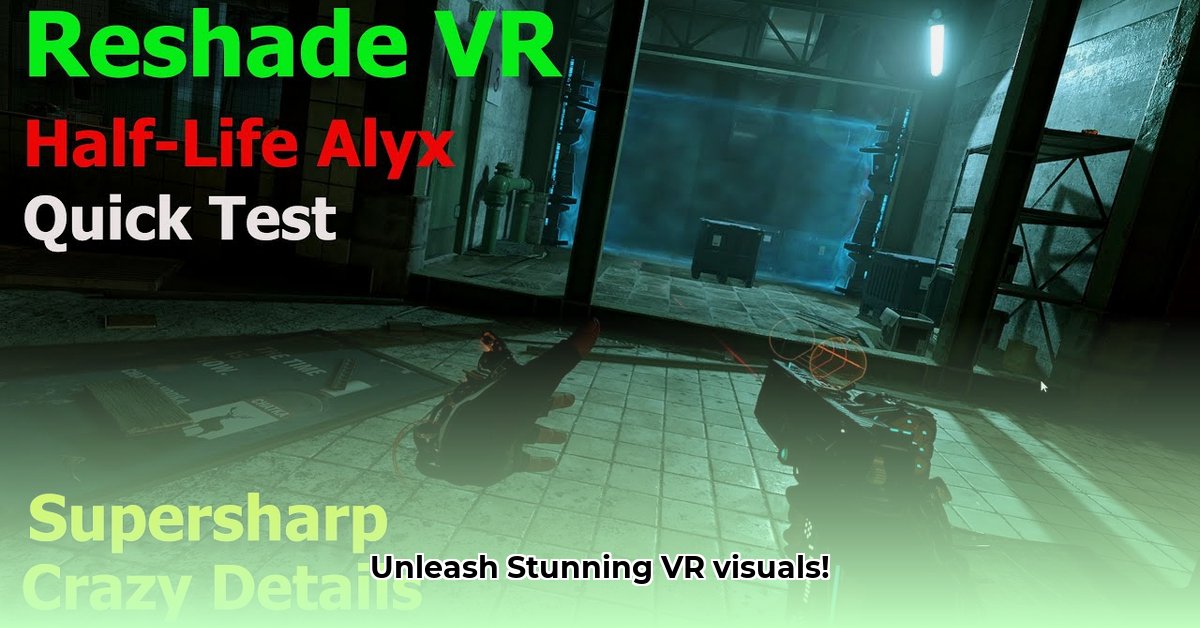
Want to elevate your VR gaming experience with sharper, more vibrant visuals? This guide will walk you through downloading and using Reshade VR with VRToolkit, a powerful tool that enhances your games without significantly impacting performance. We'll cover everything from prerequisites to troubleshooting, ensuring you achieve stunning results.
Before You Begin: System Requirements and Preparation
Before we embark on this visual journey, let's ensure your system is ready. Think of this as prepping your ingredients before you start baking—you need the right components for success.
Compatible VR Headset: You'll need a VR headset such as an Oculus Rift, HTC Vive, Valve Index, or other compatible models. VRToolkit's compatibility may vary depending on the headset model, so check the VRToolkit documentation for specifics.
Powerful Gaming PC: Reshade VR and VRToolkit demand a capable system. Your PC needs sufficient processing power and a powerful graphics card (GPU) to handle the additional visual processing. Check the system requirements for your specific VR games, and consider upgrading if needed.
Reshade: This is the foundation for our visual enhancements. Download and install the latest version of Reshade from its official website. (Think of ReShade as the base layer of paint for your masterpiece.)
VRToolkit: This is the key to applying powerful visual enhancements within Reshade. Download the latest version from its official website. (https://vrtoolkit.retrolux.de/)
Basic Tech Skills: While you don't need to be a programmer, some basic familiarity with file management and understanding where files are located on your computer is recommended.
Step-by-Step Installation and Configuration: A Detailed Walkthrough
Let's get those amazing visuals! Follow these steps carefully, and remember that patience and attention to detail are key.
Install Reshade: Download and install Reshade following the instructions on their official website. Carefully select the correct graphics API (DirectX or Vulkan) based on your VR game. Incorrect selection may prevent the software from working correctly.
Install VRToolkit: Once Reshade is installed, download VRToolkit. Copy the necessary DLL files into the effects folder within your Reshade installation directory. The exact location of this folder will vary depending on which games you intend to enhance, but typically resides within the game's directory.
Locate Your Game Executable: Find the executable file (.exe) of the VR game you want to enhance. This file is what starts the game.
Run the Game and Access Reshade: Launch your VR game. Press the designated key combination to access the ReShade interface (often Home or Shift+F2). This opens the control panel for adjusting VRToolkit's settings. This is where the magic happens.
Configure VRToolkit Settings: VRToolkit offers various parameters to fine-tune your visual experience. Experiment with settings like sharpening strength, color correction, and other options. Start with conservative settings, and gradually increase intensity to find the optimal balance between visual improvement and performance. The most common settings are sharpening strength, anti-aliasing, and color correction. Higher values may result in increased visual fidelity, but often at the cost of performance.
Testing and Refinement: Play your game and experiment with different settings until you achieve the desired visual quality. Remember, there is always a trade-off between improved visuals and performance—start with lower settings and gradually increase for optimal results.
Fine-Tuning Your VR Experience: Optimizing Settings for Optimal Performance
VRToolkit offers a wealth of customization options. Experimenting with these settings allows you to fine-tune your visuals and performance. Consider the following:
- Sharpening: Increases image sharpness, but excessive sharpening can lead to artifacts (unnatural visual distortions).
- Color Correction: Adjusts vibrancy and saturation. Subtle adjustments often yield the best results.
- Anti-aliasing: Smooths jagged edges, but can negatively impact performance.
Remember, higher settings generally offer better visuals but at the cost of performance. Find the perfect balance for your system.
Troubleshooting: Addressing Common Installation and Configuration Issues
Even with careful execution, issues can arise. Here are solutions for common problems:
- Game Crashes: Incompatibility is a common culprit. Ensure your game, Reshade, and VRToolkit versions are compatible. Try decreasing the intensity of VRToolkit's effects.
- Poor Performance: Reduce the intensity of the applied effects or disable some entirely. A powerful computer is essential for using these enhancements. Consider upgrading your graphics card to improve performance if necessary.
- Visual Glitches: Reinstall Reshade and VRToolkit, ensuring all files are correctly placed. Updates can often resolve such issues.
Performance Optimization: Balancing Visual Quality and Frame Rate
The goal is stunning visuals without sacrificing performance. These tips help:
- Lower Settings: Always start with lower intensity settings and gradually increase them.
- Disable Unnecessary Effects: Experiment with disabling effects to identify those most impacting performance.
- Monitor Frame Rate (FPS): Use in-game tools or third-party software to monitor FPS.
With patience and experimentation, Reshade VR and VRToolkit can significantly improve your VR gaming experience. Remember to share your experiences and settings with the VR community – collaboration and shared knowledge are paramount in this field.
⭐⭐⭐⭐☆ (4.8)
Download via Link 1
Download via Link 2
Last updated: Wednesday, April 30, 2025